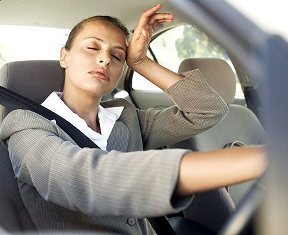Drowsy Driving Overlooked as Road Safety Problem
Most of the discussion in the distracted driving debate centers around the use of cell phones. It’s certainly a major concern, one that should be at the forefront for anyone involved in making our roads safer. But there’s an overlooked form of distracted driving, one that has existed since the invention of the automobile.
Distracted Driving vs. Drowsy Driving
Traffic accidents related to sleep deprived drivers is a major contributor to the total number of fatalities on our roads. Just take a look at how drowsy driving compares to the entire list of factors that fall under distracted driving (texting, phone conversations, talking to passengers, grooming, reading, adjusting the radio or mp3 player, eating and drinking):
– The National Highway Traffic Safety Administration estimates that every year, 100,000 police-reported crashes are a direct result of driver fatigue. These accidents result in an estimated 1,550 deaths, 71,000 injuries, and $12.5 billion in losses.
– According to the Department of Transportation, 3,092 people were killed in traffic accidents involving a distracted driver and an estimated additional 416,000 were injured.
Yes, distracted driving accidents have killed almost exactly twice as many people as drowsy driving by these estimates (along with a disproportionately higher number of injuries). However, driver fatigue is certainly significant enough to get wider play in the campaign for road safety.
One important factor to consider in these estimates is the wildcard present in drowsy driving: driver fatigue is not an easily identifiable factor, unlike the blood alcohol level that can be pointed at for drunk driving or phone and text records of a distracted driver.
Besides the most important risk factor associated with driving while tired (injury or death), there have been cases that have led to jail time for the accused and million dollar settlements. For the safety of you, fellow travelers, and your pocketbook… drive only when you are alert!
 Most of the discussion in the distracted driving debate centers around the use of cell phones. It’s certainly a major concern, one that should be at the forefront for anyone involved in making our roads safer. But there’s an overlooked form of distracted driving, one that has existed since the invention of the automobile.
Most of the discussion in the distracted driving debate centers around the use of cell phones. It’s certainly a major concern, one that should be at the forefront for anyone involved in making our roads safer. But there’s an overlooked form of distracted driving, one that has existed since the invention of the automobile.
Distracted Driving vs. Drowsy Driving
Traffic accidents related to sleep deprived drivers is a major contributor to the total number of fatalities on our roads. Just take a look at how drowsy driving compares to the entire list of factors that fall under distracted driving (texting, phone conversations, talking to passengers, grooming, reading, adjusting the radio or mp3 player, eating and drinking):
- The National Highway Traffic Safety Administration estimates that every year, 100,000 police-reported crashes are a direct result of driver fatigue. These accidents result in an estimated 1,550 deaths, 71,000 injuries, and $12.5 billion in losses.
According to the Department of Transportation, 3,092 people were killed in traffic accidents involving a distracted driver and an estimated additional 416,000 were injured.
Yes, distracted driving accidents have killed almost exactly twice as many people as drowsy driving by these estimates (along with a disproportionately higher number of injuries). However, driver fatigue is certainly significant enough to get wider play in the campaign for road safety.
One important factor to consider in these estimates is the wildcard present in drowsy driving: driver fatigue is not an easily identifiable factor, unlike the blood alcohol level that can be pointed at for drunk driving or phone and text records of a distracted driver.
Besides the most important risk factor associated with driving while tired (injury or death), there have been cases that have led to jail time for the accused and million dollar settlements. For the safety of you, fellow travelers, and your pocketbook… drive only when you are alert!

 Most of the discussion in the distracted driving debate centers around the use of cell phones. It’s certainly a major concern, one that should be at the forefront for anyone involved in making our roads safer. But there’s an overlooked form of distracted driving, one that has existed since the invention of the automobile.
Most of the discussion in the distracted driving debate centers around the use of cell phones. It’s certainly a major concern, one that should be at the forefront for anyone involved in making our roads safer. But there’s an overlooked form of distracted driving, one that has existed since the invention of the automobile.